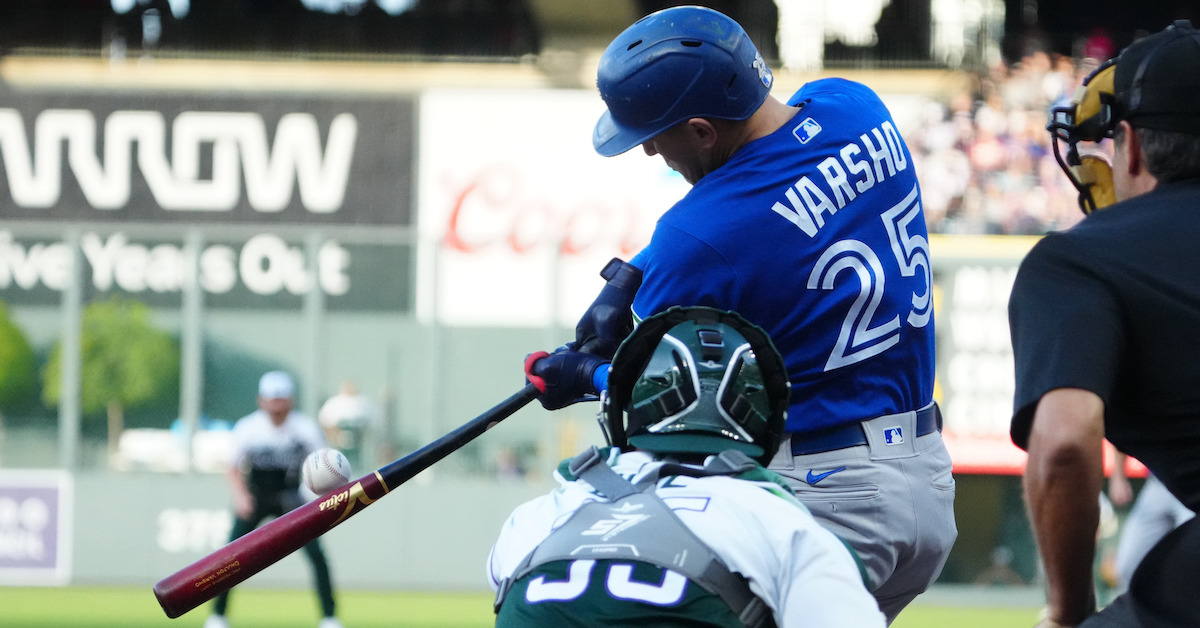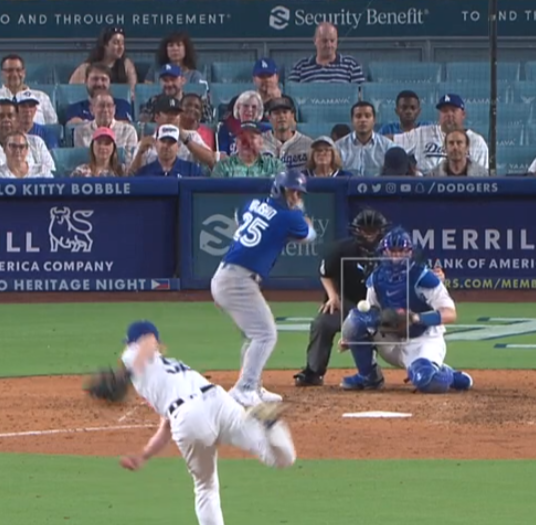Daulton Varsho Is Cleaning up His Process

I’ve wanted to write about Daulton Varsho for a long time. As a catcher turned elite defensive outfielder, he’s had a rare career progression. Because of that, he’s been one of my favorite players to watch. But I’m not here to talk about his defense, or even his elite baserunning for that matter. Instead, the focus is going to be on his one non-elite skill: his bat.
Through 1,603 career plate appearances, Varsho has a 96 wRC+. He was a slightly above-average hitter from 2021-2022, but he took a big step back in his first year with the Blue Jays, posting an 85 wRC+ across 581 plate appearances. His peripherals were about the same as they were the previous year, but his output was significantly worse. It was confusing to see. The expectation was that he would make a leap in his third full season, and the projections supported that. ZiPS’ median projection had him pegged for a 117 OPS+; his actual production ended up being a bottom decile outcome. Despite the regression, ZiPS is still confident Varsho can be a little better than league average with the bat this season, with a projected 107 wRC+.
Any hitter who saw as big of a drop as Varsho did last year would be keen to overhaul his process, though at times it can be difficult to determine what part of the profile needs the most attention. Luckily for Varsho, his was an obvious diagnosis that had little to do with his approach; his swing decisions actually improved in 2023. Instead, the problem can be found in his bat tracking data.
Let’s quickly redefine some terms before starting the analysis. First is Vertical Entry Angle (VEA): Sourcing the definition (and data) from SwingGraphs, VEA is the vertical angle of the bat approximately 83 milliseconds before contact, or in other words, the angle of the bat relative to the ground at the start of the down swing. Then there is Vertical Bat Angle (VBA), something I’ve cited many times in previous work. VBA is the angle of the bat relative to the ground at contact. Lastly, there is Attack Angle (AA), which represents the vertical direction of the bat at contact.
Each of these measurements are important for understanding any hitter. The way they work and interact with one another can tell the story of a swing. For Varsho, the way these measurements work together is especially important because he tends to live on the extreme ends of them. Here is a table summarizing his VBA and AA relative to the league:
| Year | VBA | VBA Pctile | AA Pctile |
|---|---|---|---|
| 2021 | 25.8 | NA | NA |
| 2022 | 26.5 | 4th | 99th |
| 2023 | 27.1 | 9th | 60th |
Varsho’s VBA is consistently one of the lowest in baseball. That means on average, his bat is flatter at the point of contact than most of the league. While it’s important to note that VBA is dependent on pitch height (VBA decreases as you move up in the zone), it’s not as if Varsho is only making contact with high pitches and that alone is the reason for his low mark. In fact, his contact heights are typically average or below average – not exactly the hitter you’d expect to have a VBA this low. Then, when it comes to AA, his mark was among the highest in 2022 and above average in 2023. Both years, he was among the leaders in positive differential between VBA and AA (AA > VBA). That is interesting, and perhaps a big red flag considering his profile as a hitter.
There is no such thing as an absolute in baseball – there is always room for departure from the norm – but it’s typically not optimal for a hitter to change the angle of his bat this much through his swing. If you hit the ball hard, you can probably make it work better than most, but Varsho doesn’t have that kind of room for error. Taking the bat off its natural plane of movement will likely result in lots of mishits. Unsurprisingly, Varsho was among the league leaders in pop-up rate in 2023. This swing profile is far from ideal, especially because he doesn’t have the power to overcome the deficiencies. Now is a good time to pivot to VEA and its role in Varsho’s swing.
I did not include VEA in the table because the number is best represented by a range, since the metric is still a work in progress at SwingGraphs and the capture rate isn’t always consistent. From September 2022 through last season, Varsho’s VEA has fluctuated between 42 and 48 degrees. That means he tends to flatten his bat from the start of the downswing through contact at a range between 16 to 21 degrees. Again, that is among the highest in baseball, if not the very highest.
Here is a quick screenshot of about where VEA is captured:

So, from the point you see above to contact (VEA to VBA), he flattens his bat angle a ton. That helps put the pieces of Varsho’s swing puzzle together. Think about it from a reciprocal movement perspective. How you set yourself up to move will directly impact the next step in the kinetic chain. If your bat is pointing upward as the downswing begins, then its natural response is to have a vertically oriented path through the ball, hence Varsho’s high VEA into high AA. By making his barrel flat at impact (despite moving it on an upward path), he’s forcing it off its natural path, which has a negative effect on his contact quality. Let’s watch a few swings from last year to remember what his swing actually looks like:
There are some swings where it goes right and others where it goes wrong. What’s clear even from this handful is that Varsho tinkered with his hand placement throughout last season, perhaps in an attempt to get comfortable through a bumpy year. When he spoke to David Laurila a few weeks ago, he discussed his mindset at the plate. After Laurila pointed out to Varsho that he pulls the ball more often than any hitter in the league and followed up by asking if Varsho wanted to lift the ball, the Jays outfielder made it clear that his thought process is to hit grounders. This stuck out to me – not because of any criticism of the old school mindset – but because of how he sets his swing up.
As I’ve pointed out, Varsho’s VEA puts him in line for a steep swing, but his intent to hit the ball on the ground plays out through his flat VBA. The flat VBA itself isn’t the issue. Plenty of other hitters have success with it. It’s that he doesn’t optimally set himself up to have a flat swing. If he started his downswing flatter, he would be in a better position to execute on the flat swing he intends to have. Cue 2024 spring training:
Well, I’m intrigued. Yeah, the results are better in the small sample, but that doesn’t really matter here. This is as sound of a process as I could have imagined for Varsho. If his goal is to have a low, line drive oriented swing, then this is how he should set up for it.
He points his bat down in his stance to remind him to keep the bat flat as he starts his swing. The open stance is probably a comfort thing, but it could help create more space for him to get his bat going deeper in the zone. That’s something easier to do with a flat bat path than a steep one. Either way, these adjustments align with his stated plan and the other components of his swing.
As of now, it’s unclear whether these changes will result in the offensive breakout we were expecting last year. We’ll need regular season data to answer that question. But what it does do is prove that Varsho is cleaning up his process and matching his mental plan to his physical mechanics. That’s important. If he can return to his league-average hitting, it’ll be enough to make him a valuable player, given his elite fielding and baserunning. If he can be better than that, he’ll emerge as one of the game’s more talented stars. For now, let’s see how April goes.
Esteban is a contributing writer at FanGraphs. One of his main hobbies is taking dry hacks every time he sees a bat.

Such a cool breakdown. I love this kind of stuff. I can’t get over the jays trading Moreno and gurriel for this guy — one of the most confusing and bad trades in the last few years, I think, given that teams don’t trade top 5 prospects like that anymore, and that gurriel might be just as good as Varsho or better (though obviously different). Like Moreno is head and shoulders better than anybody traded for Soto, Burnes, or Cease…